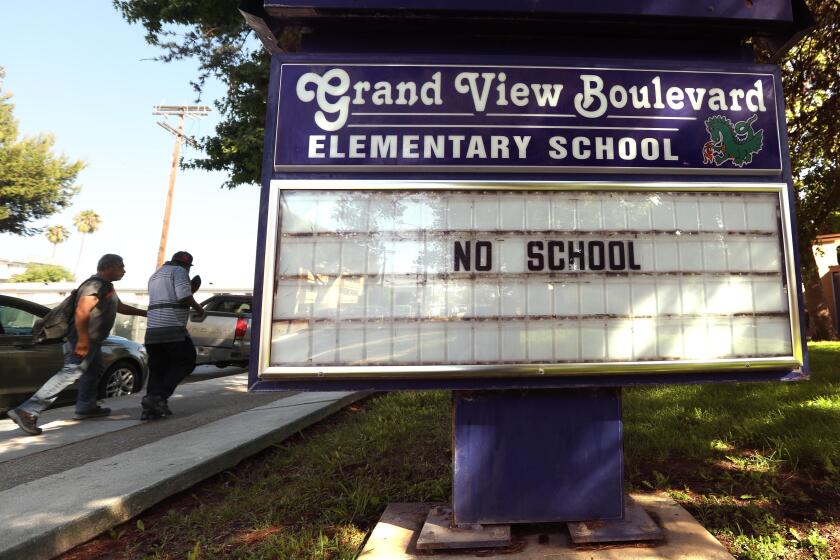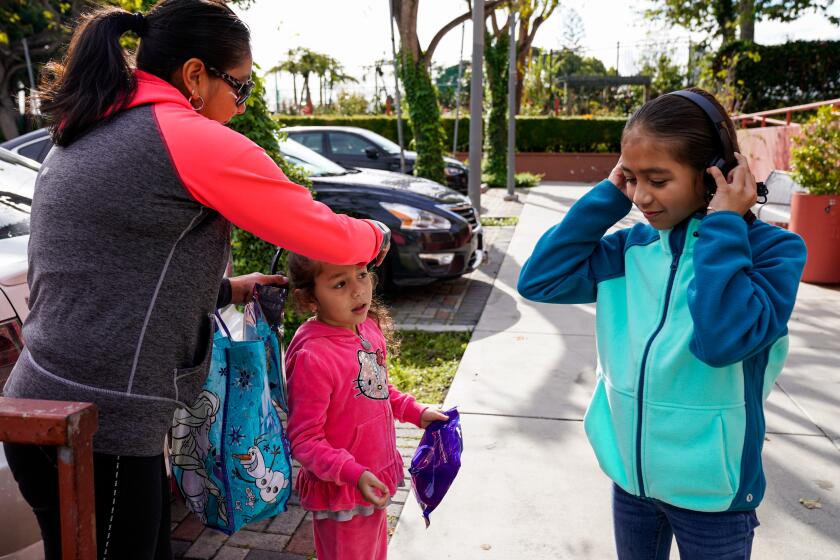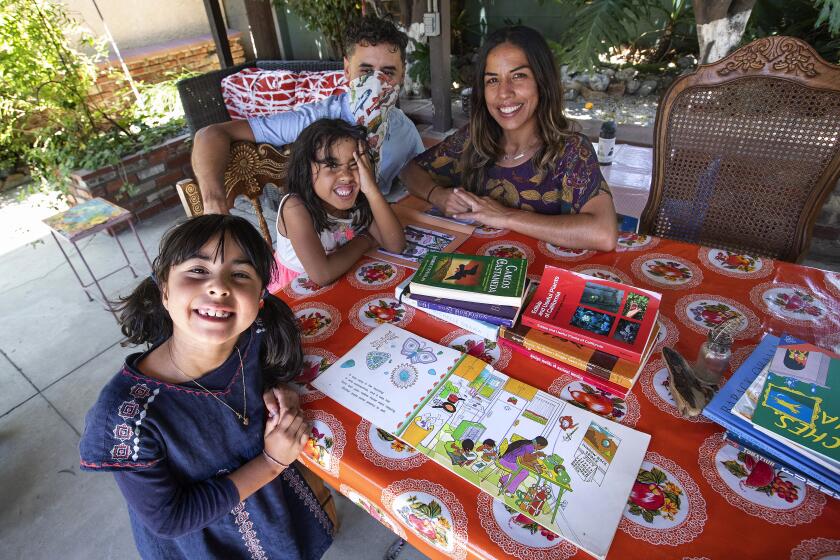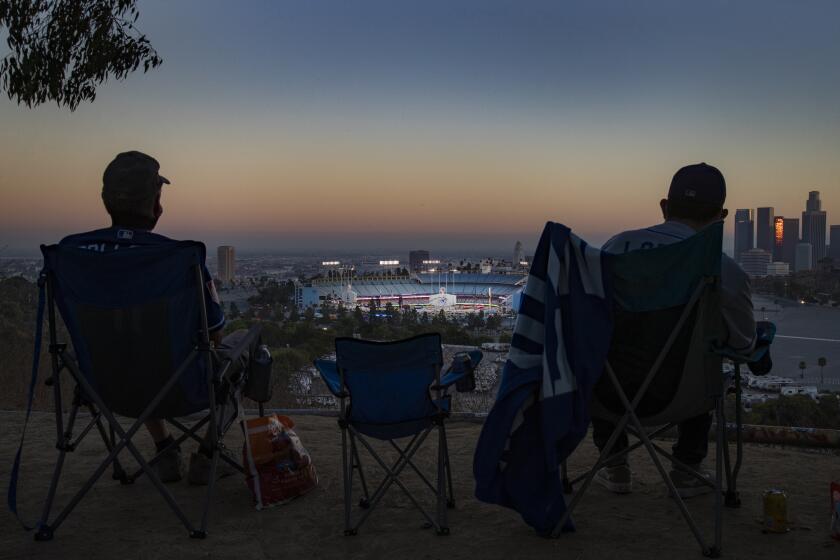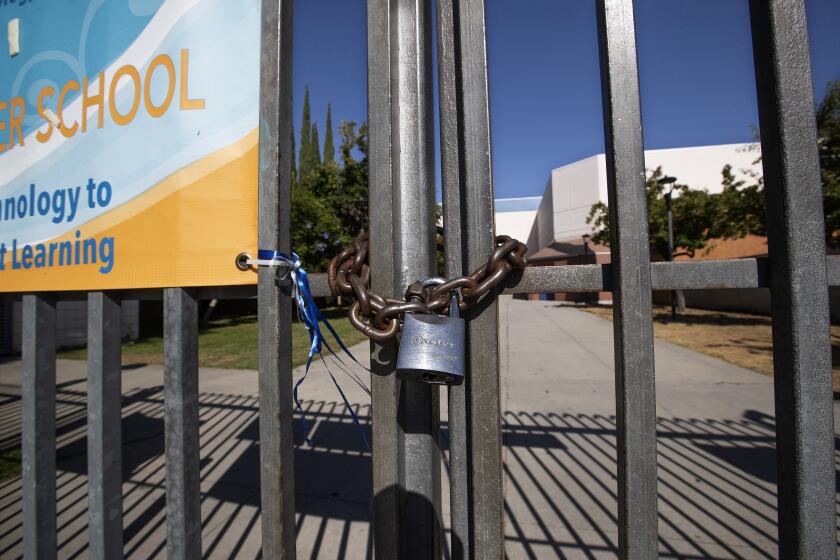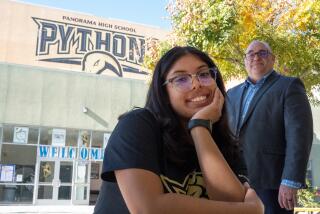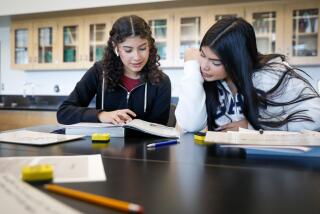‘I don’t know what I’m supposed to do.’ Parents in distress over school opening online
- Share via
How do we start school online? I have five children and one Wi-Fi hot spot. I can’t answer the questions my children are asking. The kids have way too much free time. What took so long to come up with this schedule? We need help.
As a more detailed picture of the new online-only school day in Los Angeles emerges, a crescendo of concerns and questions is arising among parents, whose children will be expected to fire up computers in less than two weeks for the opening of the 2020-21 school year amid a global pandemic.
The broad outline of a tentative agreement between the teachers union and school district is clear: Students and parents will follow a predictable schedule that somewhat mirrors a traditional school day. And there will be more live, face-to-face time, via computer, with teachers and counselors.
Because of the spike in coronavirus cases, Los Angeles public school campuses will not reopen for classes Aug. 18 and will remain shut indefinitely.
But what parents are not seeing — and what many say they desperately need — is assistance with child care, a full school day, supervised activities after school and real-time academic supervision. All would be needed for them to return fully to work and for their children to catch up and keep pace in their studies.
And, while having a structured online school day should enhance learning, some parents worry that the new schedule and rules, which will require daily attendance, will result in more intense demands to carry out a role that many say they are not qualified to handle — that of co-teacher.
“The school district doesn’t understand we’re not qualified to answer a lot of questions our kids are asking,” said Adriana Ruiz, a mother of five children in Cudahy who also serves as a caregiver for her 51-year-old sister. “That’s the frustrating part. It’s like the school’s saying, ‘Hey, we’re here for two hours and then you’re on your own.’”
Her children, ages 10 to 16, attend Cudahy’s Elizabeth Learning Center — some are still learning English and others have special learning needs. She does not see her family’s situation getting much better.
“I think it’s a good start, but it’s not enough,” Ruiz said of the schedule. “You’re leaving the children with a lot of free time.”
At Tuesday’s board meeting, officials pledged to provide district families — about 80% of whom are low-income — with many answers in the next few days, via a new handbook and direct contact from schools.
For elementary grades, the school day would begin at 9 a.m. with an activity related to social and emotional learning. The idea is that for learning to be successful, schools first need to address the trauma associated with COVID-19 and the loss of social interaction and personal development that a campus setting provides.
The agreement does not spell out what such activities would look like, but they could include icebreakers in which students develop friendships or talk about experiences or feelings important to them. The district will release sample activities.
Students will have a more predictable learning schedule under an agreement between the teachers union and L.A. Unified amid the coronavirus outbreak.
This element is crucial because parents reported in a union survey that students were sad and anxious, said Arlene Inouye, a leader of the union’s bargaining team, in a video session to announce the pact.
The typical morning continues with two sessions of instruction divided by breaks. These sessions are supposed to concentrate on math and English. A third morning session can teach music, art, science, social science, health and physical education.
Lunch — at home, of course — is scheduled to begin just before noon.
There are two sessions in the early afternoon, which have a somewhat different focus and allow for a teacher to work live with small groups. This offers an opportunity, for example, for a teacher to provide special assistance to students who are learning English, guide a small group project or work with high-achieving students who need an extra challenge.
The typical school day ends with a 50-minute period for office hours by appointment or teacher planning time.
All learning sessions don’t have to be live, but live sessions have to be part of the day. For example, in fourth grade, students must have 90 minutes of live interaction on Monday and 120 minutes each day on Tuesday through Friday. Live instruction would include full-class videoconferencing, students working with one another online under active teacher guidance or a teacher working with smaller groups.
Other kinds of learning would occupy 120 to 150 minutes. These would include students working independently offline or online, such as moving through an “instructional module” or watching a prerecorded lesson. Learning time also can include emails and chats.
For the higher grades, in which students move from class to class throughout the day, schools will use block schedules to reduce the number of videoconferences per day. For example, on one day high school students would have sessions for half their classes. On another day, they would virtually attend the other half.
There also will be smaller group advisory periods for the older students, where teachers can do a wellness check, students can connect with one another, and informal college and career counseling could take place.
Frantic parents with resources are rushing to hire tutors and form learning pods to bring distance learning to their homes and backyards amid coronavirus school closures.
The uneven instruction of last semester still makes Ruiz uneasy. She said that some teachers had been “very active” online, but most who dealt with her children were not.
“I still don’t know exactly what the plan is, who are my children’s teachers and what do they need to have before the first day of school,” she said. “My kids are anxious.”
While relieved that a plan is in place, some parents said union concerns trumped theirs.
“The school year is about to start and we as parents are here sitting in the dark waiting to find out what’s going on,” said Koreatown parent Kellyn Gonzalez.
Second wave of coronavirus has businesses and the public moving from indoors to the great outdoors
Last week, Gonzalez waited outside for hours in a heat wave with 750 other families to receive donated backpacks, school supplies and food pantry items in East Los Angeles. But she fretted that she’d need other sorts of supplies for the online education of Johnny, 6, Jayla, 5, and Jacob, 3 — all enrolled at Alexandria Avenue Elementary in East Hollywood.
Not one of her children has a tablet or laptop, she said. In the spring, they shared an older sister’s laptop and one Wi-Fi hot spot. “I don’t know what I’m supposed to do,” she said Monday afternoon.
This problem is supposed to be resolved next week, officials said, when schools will begin handing out devices as needed, although they are not likely to go to preschoolers.
School board member Monica Garcia, speaking at Tuesday’s board meeting, made a plea to parents to make sure schools have their up-to-date contact information.
A first-of-its-kind LAUSD analysis of distance learning shows deep disparities in online learning.
David Zarate, a roofing installer with three children at Belvedere Elementary in East Los Angeles, said his children stayed on top of online learning last spring because of his wife, Cynthia Moreno. He is grateful for the set schedule and live learning announced Monday.
“To know that there’s a first period, that we’re starting at 9 a.m., is really important,” he said. “You can’t have it like last year where there was like two Zoom meetings a week and you and your kids are just supposed to figure everything out.”
In September, said district officials, more help would be available to students, including one-on-one tutoring after school and on Saturdays. The hope is that students will be allowed to visit an actual classroom one at a time for this help.
L.A. schools Supt. Austin Beutner said Tuesday that he understands the pressing need for child care but that there are legal hurdles that, for now, make it difficult, if not impossible.
More to Read
Sign up for Essential California
The most important California stories and recommendations in your inbox every morning.
You may occasionally receive promotional content from the Los Angeles Times.
